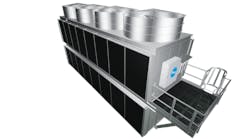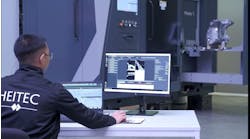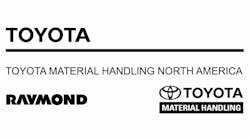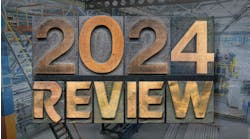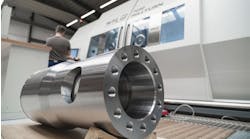At the 130th anniversary celebration of Commercial Forged Products last October, employees at the Bedford Park, IL, plant were reminded that each of them is engaged in a global competition. The statement not only emphasized the significance of the anniversary to the employees and guests, nearly 200 in total — but to underscore the importance of CFP’s new forging press.
Todd Wozniak, president of the parent company, Wozniak Industries, of Oakbrook Terrace, IL, said, “Companies we never heard of are trying to compete against us.” Jim Robinson, district director of the United Steel Workers of America, echoed these thoughts, and added, “manufacturing is a strong base for making things, for creating wealth ... jobs, a decent wage, retirement, and family.” Charles Gilyard, head of the union local told his co-workers the “future of our jobs depends upon the future of the company” and “the quality we ship in a world market.”
A global purchasing executive at Caterpillar Inc. praised CFP’s management and stated, “we are in discussions challenging them to get better in this global economy. The last 100 years is not enough ... and the new press will keep people employed.”
A commodity manager at John Deere took a different approach in his remarks, telling employees and guests that “the world is shrinking and the products made here will help produce food to feed the world.” A senior vice president of the LaSalle Bank noted that Wozniak Industries chose to be a great basic industry company, creating employment.
Wozniak said employment last year was up by more than one-third as the company moved from one to two, and then three, shifts. The third shift started recently, while the number of forgings produced annually more than doubled to close to a million parts.
George Curry, Erie Press Systems, presented a plaque to CFP, saying that his installation supervisor for the press reported that he had never worked for a better customer.
The installation was that of a 28-ft high Erie press found sitting unused in an abandoned, 300,000-ft2 former metalworking building in Tennessee. The press was produced in the early 1980s so CFP overhauled it and increased its power before installing it at Bedford Park. In its new configuration, the press has been described as unique in North America, with perhaps one similar to it in Germany.
Patrick McCarthy, CFP sales and engineering manager, said the firm concentrates on the 25% of the market that includes agriculture, mining, energy, construction equipment, off-highway products, and truck trailers.
The forging press, named “The Big Squeeze” in an employee contest, is part of a new management philosophy geared to bring business back to the United States from Europe and Asia, according to Wozniak said. “There is a greater fear to let life go by, rather than do something. If opportunity does not knock then you have to open the door.”
He explained that CFP sales personnel and design engineers looked at many large niche markets and once they determined there was a market the company could serve, they went after from the standpoints of sales, design, and a willingness to invest capital.
The president said this also applies to its General Metals Product division in St. Louis, where it has a large stamping plant with 250,000 ft2 under roof, and to the GMP Div. plant of 110,000 ft2 in Humboldt, TN. He said large investments are under way there, as well, where the company has two stamping presses (a 1,500-ton unit, and another, smaller one) and machining centers, and is expanding employment and sales. These operations produce stamped components for Bluebird and Thomas school bus bodies and roofs for Hummer vehicles
Part of the plan saw sales reps pay visits to companies that had not seen them for years, to ask how CFP could help them. Sales with one customer went from $50,000 to $5 million. Two companies once dominated the work at GMP but this is down from 80 to 40%.
Several of the CFP managers say their division can compete in price, design, engineering, quality and on-time production as they provide back-up assurance for customers.
These are among the reasons Wozniak said his company is bringing metalworking business back to the United States. He said he is committed to making his company, American metalworking, and its employment, grow. He stated, “I am passionate about this.”
The Big Squeeze, costing $5 million, is the first physical example of investment, but other capital expenditures are planned for CFP and for GMP.
When The Big Squeeze operates, people know it. Even though CFP is in a large industrial district and only five blocks from Chicago’s Midway Airport, the local metropolitan electric utility had to build a substation to accommodate the 1,300 kilowatts of electric power it requires during operation. This compares with 900 kilowatts the remainder of the plant uses. Saying it another way, it equals the 24-hour electrical use of 580 homes. CFP is believed to be the largest independent upset forge shop in North America.
First product for the new press is the forging of 300-lb axles at the rate of about one a minute for use in tree-logging systems. Metal is heated to 2,300ºF over several minutes in different coils of an induction furnace. Then, the metal is pushed onto a conveyor moving toward a robot that picks it up and places it in dies. Another robot is dedicated to spraying die lubricant onto the dies, to help keep them cool. When the forging process is completed, the axle is removed by the handling robot and put onto another conveyor and moved into a storage bin.
CFP’s McCarthy told the open house attendees that the average upset forge part made by his company weighs about 50 lb, with upset machines ranging from 3 to nearly 10 inches.
With the new press, CFP can produce axles with a flange diameter of 20 in. or larger, with an overall length of 36 in. and a shank of 5 1/2 in. The press has a rated capacity of 3,800 tons, and it can apply a forging pressure of up to 5,800 psi. The installed weight of the press comes to 554,000 lb.
McCarthy described the new press as an Erie Press/Oilgear project. Erie Press rebuilt the press to CFP’s specifications and Oilgear Co. provided a new hydraulic system.
The billet-handling robot, supplied by Rimrock Corp., uses liquid-cooled grippers that have a clamping force of two tons, with a payload of 880 lb.
The induction bar heating system has a power rating of 2,100 kW. It was supplied by Interpower Induction Services .
First, a blacksmith shop
During the anniversary open house, CFP general manager Phillip Kretekos told of how the O’Leary family founded the company in 1874, several years after the family cow allegedly kicked over a lantern and started the Great Chicago Fire. From its humble beginnings, the company grew by adding mechanized forging equipment. During World War II, the company acquired several upsetters to produce ordnance work, and gained experience in upsetting technology that continues to serve it well today. (See “Commercial Forged Products Shows Profit Gains,” July-August 2004 , p. 24.)
Today, CFP believes it is the largest independent upset forger in North America. When Wozniak acquired CFP in 1986, its sales amounted to $9 million. Sales are projected for this year at $30 million. The products CFP produces range from tubing products for the oil industry to axles and similar parts for off-road vehicles. CFP uses upsetters ranging in size from 3 in. (840 tons) to 8 in. (2,520 tons).
In a Chicago Tribune interview at the time of the open house, chairman Ed Wozniak said he believed the national hand-wringing over competition from so-called “low-cost” markets like China, Mexico, and India is overblown. He insisted that many of the manufacturing jobs that “go” overseas could be saved by opportunistic management.
“It’s easy to make the statement on the nightly news that everything is going to China,” Wozniak said. “But that’s not really true.”
One reason: labor only makes up 8% of his products’ cost, so low-cost foreign markets don’t have as much of an advantage in the forging business.
He believes the outsourcing trend presents a rich opportunity for CFP because customers like Deere and Caterpillar would rather concentrate on core competencies—designing, assembling, and marketing heavy machinery-than produce forged components. He told the Tribune that these customers would prefer for others to make parts and components so they can push costs downstream and demand lower prices each year.
Wozniak believes that this can mean a steady stream of business for companies like CFP-that deliver cost savings, and even designer services.
“They don’t want to make parts,” Wozniak explained. “They want the supplier to bear the burden of production.”
The challenge for suppliers like CFP is to maintain quality while doing everything possible to cut costs. That’s the rationale behind investing in The Big Squeeze.
The new press system cuts in half the production time required when using previous equipment, and allows CFP to produce much larger parts. It also requires only two technicians, cutting the labor content by half.
In interview with the Chicago Sun Times last summer, Wozniak said, “Our key advantages are far lower transportation costs in serving U.S. assemblers, plus far better consistency in delivery, quality control, and value-added engineering. These latter factors reflect a huge transition among the OEMs that should really dispel many myths about the specter of outsourcing.
“First, there has been a complete shift to just-in-time inventory ordering of expensive parts like these. The major assemblers just don’t keep inventories lying around. They’re ordering 6 to 18 months in advance, coordinated with assembly plans, and their greatest fear of outsourcing is that their assembly line will be shut down by a late delivery of a component. We’ve invested in immense backup capacity that has insured a 100% reliability record on deliveries.”
Wozniak sees a second change at the OEM: “Today they only want to assemble and market, not engineer and fabricate. Increasingly, they’re relying on firms like us to provide free brainpower-ideas that can save time and cost.
“Recently, John Deere ordered right and left fenders from our stamping division for a new tractor model. We asked them to let us design a new fender that was interchangeable, usable on either side, and produced from one die. The result was a home run.
“In addition, the OEM’s are seeking our management of the entire fabrication process including supervision of other suppliers serving their overseas assembly plants. We take overall responsibility, and thus our foreign competitors actually become our partners.”

